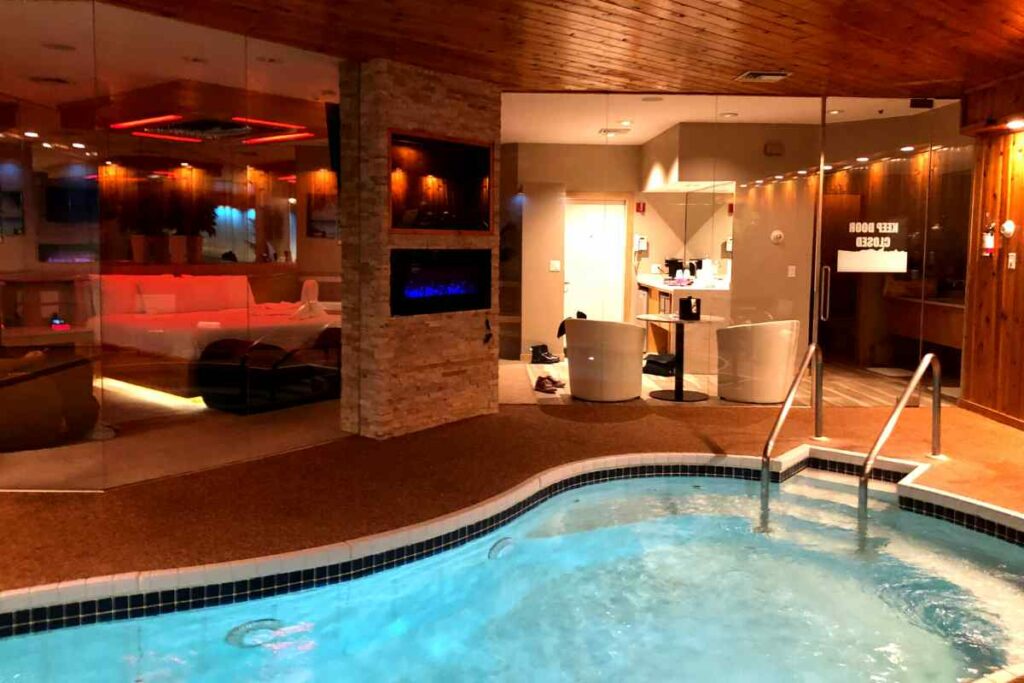

It’s a rainy, windy day in the English countryside, and I’m wandering around a 1,000-acre estate, foraging for mushrooms. Admittedly, I am not the most outdoorsy or gardening-focused of people, especially when it comes to digging around in the dirt, and even more so when the weather conditions are less than desirable. It’s a testament to this enchanting place, then, that on this cold, wet autumn day, I found myself rummaging around on the ground, picking up fungi—and, perhaps most surprisingly, actually enjoying the experience.
I was at The Newt in Somerset, a palatial property in Bruton, England situated just about two-and-a-half hours outside of London. From the moment I arrived, it was evident that The Newt was something special, and after spending three nights at the property, I can confidently say that it is one of the most magical places I’ve ever visited. The Newt is one of those rare destinations that has you dreaming about your return mere moments after leaving, which in today’s climate of countless luxury hotels and experiences, is truly quite the feat. So, what makes this property such a standout?

Subscribe to Observer’s Lifestyle Newsletter
The Newt dates back to the late 17th century, but it opened in its current iteration as a working farm-slash-hotel-slash-garden in 2019, following an impressive interior and landscaping renovation courtesy of owners Koos Bekker and Karen Roos, who purchased the estate in 2013. The final result is wonderfully luxurious but decidedly unfussy, respecting the historical features and integrity of the property, but with all the lavish and modern amenities and services that luxury-loving jet-setters have come to expect.

The Newt is composed of just 40 accommodations, which are divided between the 23 rooms at Hadspen House, which was originally built in 1690 as a farmer’s cottage, and then further designed in the Georgian era shortly thereafter, and the 17 rooms spread out at the Farmyard, a former dairy farm that’s about a half mile from Hadspen. I stayed in a room at Hadspen during my visit, and fell in the love with the airy, light-filled yet oh-so-cozy suite, complete with a private balcony, four-poster bed, fireplace, window seats and a dreamy freestanding tub.
Guests have access to the entire estate and can sign up for all spaces and activities; there’s also a membership option for those who want to visit The Newt, which costs $85 per year and provides entrance to the majority of the experiences, though certain spaces, including the spa and Farmyard restaurant, are exclusively for hotel guests.

Hadspen House still exudes the atmosphere of a cozy and welcoming private home, and during my stay, I noticed that unlike many hotels, guests actually used the charming public spaces. The snug living room is outfitted with jewel-toned plush seating, wood paneled walls and an inviting fireplace, making it a dream spot to curl up with a book, play a game of backgammon or sip afternoon tea. If you want something a bit stronger, head to the adjacent bar, which has its own blue velvet couches, petite marble tables and a crackling fireplace—I highly suggest trying any cocktail with the Newt’s signature Apple Gin, which you can sip while taking in the live music performances that are held pretty much every single evening.

The Farmyard, which opened in 2021, is just as stunning, with more of a rustic-chic edge. The landscaping is impeccable, with a picturesque pond, stacked stones and ridiculously idyllic weeping willow trees. The loft-like rooms are sprinkled throughout the collection of converted buildings, and there’s also a separate bar, where guests are encouraged to whip up and serve their own drinks, as well as an indoor pool and restaurant.
The Newt is somewhat isolated, but you’re definitely not lacking in incredible dining options. The Botanical Rooms, located within Hadspen House, are divided into two separate spaces; the glass-enclosed, airy conservatory leads to an adjacent oak-paneled dining room. The menu focuses on seasonal cuisine (during my stay, dishes included a lobster, squash and citrus creation, Jerusalem artichoke with hazelnut and elderberry, as well as beef with tarragon, mustard and anchovy), and it’s an authentic farm-to-table concept, as all of the ingredients are sourced either directly from The Newt or from neighboring estates. Every single dish at every single meal was absolutely incredible, from the first apple waste sourdough (made using the leftover pulp from the cider press!) to the final apple pie. The Farmyard restaurant is equally impressive, but with a more casual atmosphere and a shared plates-style menu that includes comforting flatbreads, roast chicken and more.

The Newt is, at its core, a garden, which happens to be the site of a hotel and restaurant. The grounds are at the heart of the property, which you could spend days on end exploring, finding new experiences and locales on every turn. Indeed, The Newt is home to 65 acres of apple orchards, which grow 70 different varietals of apples. The property uses both their own apples as well as those from local orchards to create their special cider, made on site with their own press. Peak apple harvest season was wrapping up during my visit, but I was still able to experience a cider tasting, during which I was promptly convinced to begin ordering cider as my new drink of choice. That’s just the beginning of the myriad of inventive and unique experiences at The Newt, though. There’s the aforementioned mushroom foraging expedition, of course, led by the estate’s fungi expert, during which attendees hike along the property and learn what mushrooms are edible, which to avoid and, to top it off, enjoy a mushroom-focused meal at the Garden Café, as well as woodland tours and a very fitting immersive garden storytelling exhibit.

Those who want pure relaxation time should book a massage at the spa (located in a converted cow barn), or just spend some quality lounging time by the indoor-outdoor pool. Definitely try out the steam room, sauna and hammam, though my personal favorite was the halotherapy room, complete with soothing salt walls, which also happens to be a great option for those who don’t do well in high heat.

One of my personal favorite experiences was a honey tasting with Paula Carnell, The Newt’s resident beekeeper and honey sommelier, who runs weekly Bee Safaris and heads up the Beezantium, a honeycomb-shaped waterside building where you can see the estate’s bee hives as well as check out the interactive exhibit. During the tasting, Carnell, who follows a naturopathic approach to beekeeping, walked me through the tasting (during which I learned that honey is one of the most-faked food products out there, so be careful when shopping!) and then led me on a tour through the Beezantium. “Originally, I just told them I wanted a shed, but it really evolved—they built me this entire Beezantium! They Newt-ified my idea,” Carnell laughed. I would later realize this was indicative of The Newt’s attitude towards everything on the property—they give everything their all.

That approach is on full display at The Newt’s latest addition, a reconstructed Roman villa that opened in June 2022. The concept was inspired by the discovery of ruins of a Roman-British villa that once stood on the estate; a careful excavation determined the structure dates back to 351 AD. What followed was a seven-year project led by a team of archaeologists, architects, engineers and craftsmen to carefully recreate Villa Ventorum (it means Villa of the Winds), which now stands adjacent to the ancient ruins.

The villa experience begins in the interactive visitors center and museum, where you can actually see the original exposed foundations from the ancient villa, as well as uncovered mosaic tiles, before heading off on a pathway to the neighboring Villa Ventorum, which is positioned next to an authentic replication of a Roman vineyard. Wandering through the villa, you’ll find careful reconstructions of bedrooms, kitchens, sitting rooms and even a working complex of Roman baths. “It’s as close to a living, breathing Roman villa as one could possibly get,” Ric Weeks, the on-site archaeologist and exhibition manager, told me as I walked inside, explaining that the team did their best to only use materials and techniques that would have been available at the time. They were so faithful to the concept that, upon noticing that the terracotta tiles on the roof didn’t look exactly right, the team decided to bring in an artisan who would make the tiles individually by hand, just as they were in the Roman-British era, using his thigh as the mold.

As I strolled through the villa, Weeks assured me that visitors shouldn’t be afraid to touch the frescos or sit down on the furniture. After I plopped down on a recreated daybed in the living room, I looked up to see a familiar trio on the wall in front of me—the Romans often honored their royal families with wall paintings, and in a nod to the tradition, Villa Ventorum features an image of the Prince and Princess of Wales. It’s a truly hands-on, immersive adventure that ends with a stop at the outdoor kitchen, where visitors can taste authentic Roman cuisine and sip on wine made à la ancient Romans. While I found I was partial to The Newt’s cider, the vino was still quite impressive, and just another show of how dedicated the estate is to giving visitors these special experiences.
And, it turns out, the project isn’t finished just yet—it’s still evolving. “It’s only the end of the beginning,” Weeks said, as soon, there will be a new series of demonstration spaces, and within a few years, the aforementioned Roman vineyards will start producing usable grapes for wine, which will then be made on the premises.

It’s that sentiment that sums up so much of the Newt’s ethos, and what makes it so incredibly special—there’s always more to come, which is why I’m already dreaming of a trip back to the idyllic countryside estate.
*This stay at The Newt in Somerset was courtesy of the hotel. The views and opinions expressed are the journalist’s own.*







